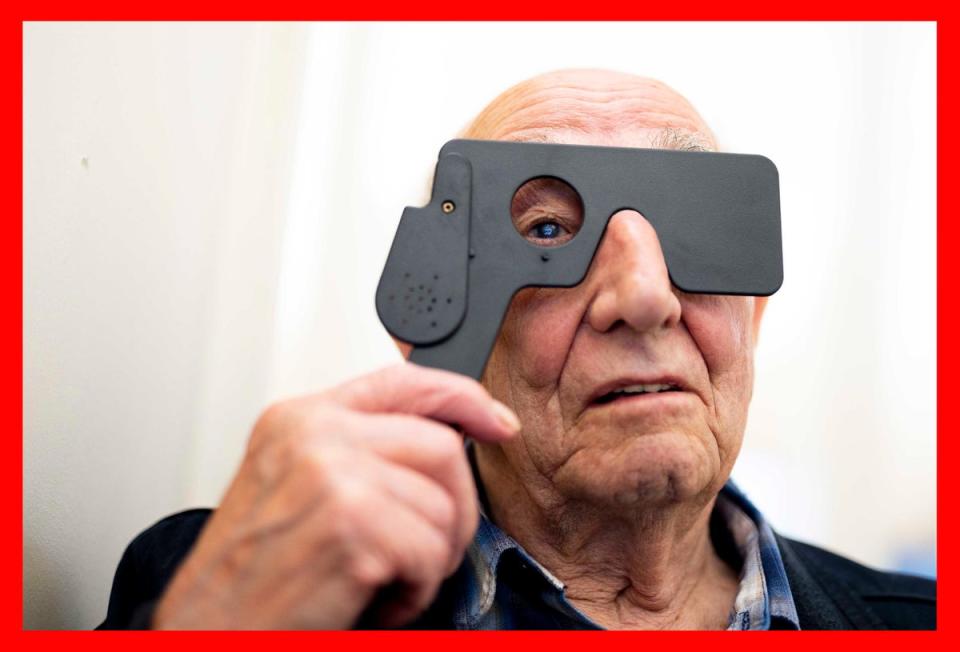Artificial cornea makes 91-year-old an NHS first for sight-saving surgery

A 91-year-old man has made history by becoming the first NHS patient in England to receive an artificial cornea.
Cecil Farley faced a year-long wait for sight-saving surgery after a human cornea transplant failed, but his surgeon offered him the chance to skip the queue by using an artificial one.
Medics hope that one day the new artificial corneas could reduce the need for human cornea donations.
Frimley Health NHS Foundation Trust consultant ophthalmologist Thomas Poole told the PA news agency the use of artificial corneas is a “great advancement for patient care”.
The new product replaces the inner part of the cornea, which is the clear outer layer at the front of the eyeball.
It has been likened to a contact lens and is surgically attached to the eye by a single stitch and put in place with a gas bubble.
Mr Farley, known to his friends as John, said the transplant surgery has enabled him to continue to see his 83-year-old wife Elizabeth.
He had no vision in his right eye but his sight has slowly been improving since the procedure, which took place in February.

Mr Farley, from Chobham in Surrey, had problems with his eye for around 15 years.
Medics from Frimley offered the procedure, which is a type of corneal implant called endothelial keratoplasty and involves removing the abnormal inner lining of the cornea and replacing it with an artificial cornea, rather than a donated human one.
“I can still see my wife after 63 years of marriage, we can just carry on as normal and live life as fully as we can,” Mr Farley said.
“It makes your life fuller when your eyes work properly – you don’t realise how debilitating it is until it happens to you.”
The pensioner, who used to own a flooring company, said that once his sight is fully restored, he wants to do practical tasks like repairing a watch but for now he is content “pottering about”.
“It has made a great difference to my sight. It was very blurred and I couldn’t distinguish a face. Now I can see better with it, the brighter the light the better. It’s coming along slowly – they said it could take up to a year,” Mr Farley said.
When a cornea is damaged as a result of injury or disease, it can become less transparent or its shape can change.
This can prevent light from reaching the retina at the back of the eye and causes the image transmitted to the brain to be distorted or unclear.
A cornea transplant can be performed to improve sight, relieve pain and treat severe infection or damage. Cornea transplants usually come from deceased donors.
Mr Poole, along with his colleague Hanbin Lee, have successfully given four patients artificial corneas in the last two months and initial results have shown an improvement in vision.
“It is a great advancement for patient care, and it’s going to be a great opportunity for some patients who either can’t wait too long or have other comorbidities in the eye,” Mr Poole said.
“We now have a very long waiting list for a human cornea, which we’ve been using for many years, very successfully. The problem is if you’ve got patients whose eyes are getting worse, you can’t get a human cornea for over a year.
“There are risks with staying on a waiting list with an unwell eye; there are risks in not doing anything as well, such as picking up an infection.
“One of the beauties of [the artificial cornea] is that it is not human tissue so the body does not try to reject it.

“Looking forward, I think this may end up replacing human corneas for certain types of corneal graft patients. In maybe 10 or 20 years, this may become the norm where we don’t need a human cornea, and we can just take one out of the box.”
In 2022-23, the latest figures available, some 4,719 corneas were supplied to NHS Blood and Transplant’s eye banks and there were 3,529 transplants.
In the past, some potential organ donors have said they were willing to donate organs including hearts, livers and kidneys but chose not to donate their corneas.
“We are so grateful to all those who agreed to donate their corneas after their death and restored or improved the sight of 3,259 people last year through corneal transplants,” said Mr Poole.
The new artificial cornea, called EndoArt, was created by the ophthalmological medical device company EyeYon Medical. Only 200 have been implanted worldwide to date, including in Mr Farley.


